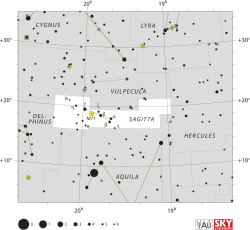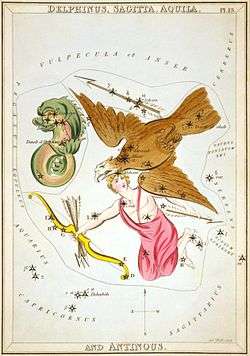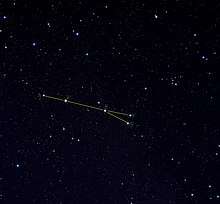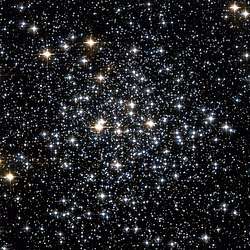Sagitta
Sagitta is a dim but distinctive constellation in the northern sky. Its name is Latin for "arrow", and it should not be confused with the significantly larger constellation Sagittarius, the archer. Although Sagitta is an ancient constellation, it has no star brighter than 3rd magnitude and has the third-smallest area of all constellations. It was included among the 48 constellations listed by the 2nd century astronomer Ptolemy, and it remains one of the 88 modern constellations defined by the International Astronomical Union. Located to the north of the equator, Sagitta can be seen from every location on Earth except within the Antarctic circle.
| Constellation | |
 | |
| Abbreviation | Sge |
|---|---|
| Genitive | Sagittae |
| Pronunciation | /səˈdʒɪtə/ Sagítta, genitive /səˈdʒɪtiː/ |
| Symbolism | the Arrow |
| Right ascension | 19.8333h |
| Declination | +18.66° |
| Quadrant | NQ4 |
| Area | 80 sq. deg. (86th) |
| Main stars | 4 |
| Bayer/Flamsteed stars | 19 |
| Stars with planets | 2 |
| Stars brighter than 3.00m | 0 |
| Stars within 10.00 pc (32.62 ly) | 1 |
| Brightest star | γ Sge (3.51m) |
| Messier objects | 1 |
| Bordering constellations | Vulpecula Hercules Aquila Delphinus |
| Visible at latitudes between +90° and −70°. Best visible at 21:00 (9 p.m.) during the month of August. | |
The red giant Gamma Sagittae is the constellation's brightest star, with an apparent magnitude of 3.47. Delta, Epsilon, Zeta and Theta Sagittae are multiple stars whose components can be seen in small telescopes. V Sagittae is a cataclysmic variable binary star system that is expected to go nova and briefly become the most luminous star in the Milky Way and one of the brightest stars in our sky around the year 2083. Two star systems have been found to have Jupiter-like planets, while a third—15 Sagittae—has a brown dwarf companion.
History

The Ancient Greeks called this constellation Oistos "the arrow".[1] It was regarded as the weapon that Hercules used to kill the eagle (Aquila) of Jove that perpetually gnawed Prometheus' liver.[2] The Arrow is located beyond the north border of Aquila, the Eagle. Richard Hinckley Allen proposed that the Arrow could be the one shot by Hercules towards the adjacent Stymphalian birds (6th labor) who had claws, beaks and wings of iron, and who lived on human flesh in the marshes of Arcadia—Aquila the Eagle, Cygnus the Swan, and Lyra (the Vulture)—and still lying between them, whence the title Herculea.[3] Eratosthenes claimed it as the arrow with which Apollo exterminated the Cyclopes.[2] The Romans named it Sagitta.[4]
In Arabic, it became al-sahm "arrow", though this name became Sham and was transferred to Alpha Sagittae only. The Greek name has also been mistranslated as ὁ istos "the loom" and thus in Arabic al-nawl. It was also called al-'anaza "pike/javelin".[1]
Characteristics
Four stars make up an arrow-shaped asterism located due north of the bright star Altair.[5] Covering 79.9 square degrees and hence 0.194% of the sky, Sagitta ranks 86th of the 88 modern constellations by area. Only Equuleus and Crux are smaller.[6] Sagitta is most readily observed from the late spring to early autumn to northern hemisphere observers, with midnight culmination occurring on 17 July.[7] Its position in the Northern Celestial Hemisphere means that the whole constellation is visible to observers north of 69°S.[6][lower-alpha 1] Sagitta is bordered by Vulpecula to the north, Hercules to the west, Aquila to the south, and Delphinus to the east. The three-letter abbreviation for the constellation, as adopted by the International Astronomical Union in 1922, is "Sge"; American astronomer Henry Norris Russell, who devised the code, had to resort to using the genitive form of the name to come up with a letter to include ('e') that was not in the name of the constellation Sagittarius.[8] The official constellation boundaries, as set by Eugène Delporte in 1930, are defined by a polygon of twelve segments (illustrated in infobox). In the equatorial coordinate system, the right ascension coordinates of these borders lie between 18h 57.2m and 20h 20.5m, while the declination coordinates are between 16.08° and 21.64°.[9]
Notable features

Stars
Johann Bayer gave Bayer designations to eight stars, labelling them Alpha to Theta. What was viewed by Bayer, Friedrich Wilhelm Argelander and Heis as a single star Theta was in fact three stars, and is now equated to HR 7705. John Flamsteed added the letters x (mistaken as Chi), y and z to 13, 14 and 15 Sagittae in his Catalogus Britannicus. All three were dropped by later astronomers John Bevis and Francis Baily.[10]
In his Uranometria, Bayer depicted Alpha, Beta and Epsilon Sagittae as the fins of the arrow.[11] Also known as Sham, Alpha is a yellow bright giant star of spectral class G1 II (with an apparent magnitude of 4.38, which lies at a distance of 382 ± 8 light-years from Earth.[12] Originally 4 times as massive as the Sun, it has swollen and brightened to 20 times its diameter and 340 times its luminosity.[13] Also of magnitude 4.38, Beta is a G-type giant located 420 ± 10 light-years distant from Earth.[14] Estimated to be around 129 million years old, it is 4.33 times as massive as the Sun,[15] and has expanded to roughly 27 times its diameter.[16] Epsilon Sagittae is a double star whose component stars can be seen in a small telescope.[17] With an apparent magnitude of 5.77,[18] the main star is a 331-million year-old yellow giant of spectral type G8 III around 3.09 times as massive as the Sun,[19] that has swollen to 18.37+0.65
−0.88 its diameter.[20] It is 580 ± 10 light-years distant.[20] Its companion of magnitude 8.35 is 87.4 arc seconds distant,[18] but is actually an unrelated blue supergiant around 7,000 light-years distant from Earth.[21]
Ptolemy saw the constellation's brightest star Gamma Sagittae as marking the arrow's head,[22] while Bayer saw Gamma, Eta and Theta as depicting the arrow's shaft.[11] Gamma Sagittae is a red giant of spectral type M0III,[23] and magnitude 3.47. It lies at a distance of 258 ± 4 light-years from Earth.[24] It has around 90% of the Sun's mass yet has a radius 54 times that of the Sun and is 575 times as bright. It is most likely on the red-giant branch of its evolutionary lifespan, having exhausted its core hydrogen and now burning it in its shell.[25]
Eta Sagittae is an orange giant of spectral class K2 III with a magnitude of 5.1. Located 155.9 ± 0.9 light-years from Earth, it has a 61.1% chance of being a member of the Hyades-Pleiades stream of stars that share a common motion through space.[26] Theta Sagittae is a multiple star system, with two components 12 arcseconds apart visible in a small telescope.[17]
Delta and Zeta depicted the spike according to Bayer.[11] both of these stars are separable into multiple component stars in a small telescope.[17] Delta Sagittae is a suspected visual double - M2 II+A0 V probably single image, composite spectrum), magnitude 3.82. Zeta Sagittae is a triple system, approximately 326 light-years from Earth, the primary an A-type star.
FG Sagittae is a remote highly luminous star around 4000 light years distant from Earth.[27] WR 124 is a Wolf-Rayet star moving at great speed surrounded by a nebula of ejected gas. HD 183143 is a remote blue-white star around 6500 light-years away that has been described as a blue hypergiant. It is an Alpha Cygni variable.
R Sagittae is a member of the rare RV Tauri variable class of star. It ranges in magnitude from 8.2 to 10.4.[28] It is around 8,100 light-years distant.[29] It has a diameter 61.2+12.4
−9.9 times that of the Sun, and is 2,329+744
−638 as luminous, yet most likely to be less massive than the Sun. An ageing star, it has moved on from the asymptotic giant branch of stellar evolution and is on its way to becoming a planetary nebula.[30]
S Sagittae is a Classical Cepheid that varies from magnitude 5.24 to 6.04 every 8.38 days. It is a yellow-white supergiant that pulsates between spectral types F6Ib and G5Ib.[31] Around 6 or 7 times as massive and 3500 times as luminous as the Sun,[32] it is located around 5,100 light-years away from Earth.[33]
U Sagittae is an eclipsing binary that varies in brightness between magnitudes 6.6 and 9.2 over 3.4 days, making it a suitable target for enthusiasts with small telescopes.[5] The system is 900 ± 10 light-years distant.[34]
X Sagittae is a semiregular variable ranging between magnitudes 7.9 and 8.4 over 196 days.[5] A carbon star, it has a surface temperature of 2576 K. [35]
Located near 18 Sagittae is V Sagittae, the prototype of the V Sagittae variables, cataclysmic variables that are also super soft X-ray source.[28] It is expected to become a luminous red nova when the two stars merge around the year 2083, and briefly become the most luminous star in the Milky Way and one of the brightest stars in our sky.[36][37] WZ Sagittae is another cataclysmic variable, composed of a white dwarf that has about 85% the mass of the Sun, and low mass star companion that has been calculated to be a brown dwarf of spectral class L2 that is only 8% as massive as the Sun.[38] Normally a faint object dimmer than magnitude 15, it flared up in 1913, 1946 and 1978 to be visible in binoculars.[5] The black widow pulsar (B1957+20) is the second millisecond pulsar ever discovered.[39] It is a massive neutron star that is ablating its brown dwarf-sized companion which causes the pulsar's radio signals to attenuate as they pass through the outflowing material.[40]

HD 231701 is a yellow-white main sequence star hotter and larger than our Sun, with a Jupiter-like planet that was discovered in 2007 by the radial velocity technique . The planet orbits at a distance of 0.57 AU from the star with a period of 141.6 days.[41] HAT-P-34 is a star 1.392 ± 0.047 times as massive as the Sun with 1.535+0.135 −0.102 times its radius and 3.63+0.75− 0.51 times its luminosity. With an apparent magnitude of 10.4,[42] it is 819 ± 9 light-years distant.[43] A planet 3.328 ± 0.211 times as massive as Jupiter was discovered transiting it in 2012. With a period of 5.45 days and a distance of 0.06 astronomical units from its star, it has an estimated surface temperature of 1520 ± 60 K.[42] 15 Sagittae is a solar analog—a star similar to the Sun, with 1.08 ± 0.04 times its mass, 1.115 ± 0.021 times its radius and 1.338 ± 0.03 times its luminosity. It has a brown dwarf substellar companion that is around the same size as Jupiter but 69 times as massive with a surface temperature of between 1,510 and 1,850 K, taking around 73.3 years to complete an orbit around the star. The system is estimated to be 2.5 ± 1.8 billion years old.[44]
Deep-sky objects
The band of the Milky Way and the Great Rift within it pass though Sagitta, with Alpha, Beta and Epsilon Sagittae marking the Rift's border.[45] Located between Beta and Gamma Sagittae is Messier 71,[5] a very loose globular cluster mistaken for quite some time for a dense open cluster.[46] At a distance of about 13,000 light-years from Earth, [47] it was first discovered by the French astronomer Philippe Loys de Chéseaux in the year 1745 or 1746.[46]
There are two notable planetary nebulae in Sagitta: NGC 6886—composed of a hot central post-AGB star that has 55% of the Sun's mass yet 2700 ± 850 times its luminosity, with a surface teperature of 142,000 K, and surrounding nebula estimated to have been expanding for between 1280 and 1600 years,[48] and the Necklace Nebula—originally a close binary that one component of which swallowed the other as it expanded to become a giant star. The smaller star remained in orbit inside the larger, whose rotation speed increased greatly, resulting in it flinging its outer layers off into space, forming a ring with knots of bright gas formed from clumps of stellar material.[49] Both nebulae are around 15,000 light-years distant from Earth.[48][49]
Notes
- While parts of the constellation technically rise above the horizon to observers between the 69°S and 73°S, stars within a few degrees of the horizon are to all intents and purposes unobservable.[6]
References
- Kunitzsch, Paul (2002). "Albumasariana" (PDF). Annali Istituto Universitario Orientale di Napoli. OPAR L'Orientale Open Archive. p. 4. Retrieved 30 January 2020.
- Hyginus. "Astronomica". Translated by Mary Grant. Retrieved 2020-01-31.
- Richard Hinckley Allen (25 October 2018). Star-Names and Their Meanings. FRANKLIN CLASSICS TRADE Press. ISBN 978-0-344-21405-9.
- M., Bagnall, Philip (2012). The star atlas companion : what you need to know about the constellations. Springer. ISBN 9781461408307. OCLC 794225463.
- Moore, Patrick (2005). The Observer's Year: 366 Nights in the Universe. New York: Springer Science & Business Media. p. 10. ISBN 978-1-85233-884-8.
- Ridpath, Ian. "Constellations: Lacerta–Vulpecula". Star Tales. self-published. Retrieved 22 May 2015.
- Thompson, Robert Bruce; Barbara Fritchman (2007). Illustrated Guide to Astronomical Wonders: From Novice to Master Observer. Sebastopol, California: O'Reilly Media, Inc. p. 392. ISBN 978-0-596-52685-6.
- Russell, Henry Norris (1922). "The New International Symbols for the Constellations". Popular Astronomy. 30: 469. Bibcode:1922PA.....30..469R.
- "Sagitta, Constellation Boundary". The Constellations. International Astronomical Union. Retrieved 22 May 2015.
- Wagman 2003, pp. 266–67.
- Wagman 2003, p. 515.
- Brown, A. G. A.; et al. (Gaia collaboration) (August 2018). "Gaia Data Release 2: Summary of the contents and survey properties". Astronomy & Astrophysics. 616. A1. arXiv:1804.09365. Bibcode:2018A&A...616A...1G. doi:10.1051/0004-6361/201833051. Gaia DR2 record for this source at VizieR.
- Kaler, James B. "Sham". Stars. University of Illinois. Retrieved 22 May 2015.
- Brown, A. G. A.; et al. (Gaia collaboration) (August 2018). "Gaia Data Release 2: Summary of the contents and survey properties". Astronomy & Astrophysics. 616. A1. arXiv:1804.09365. Bibcode:2018A&A...616A...1G. doi:10.1051/0004-6361/201833051. Gaia DR2 record for this source at VizieR.
- Liu, Y. J.; et al. (2014). "The Lithium Abundances of a Large Sample of Red Giants". The Astrophysical Journal. 785 (2): 12. arXiv:1404.1687. Bibcode:2014ApJ...785...94L. doi:10.1088/0004-637X/785/2/94. 94.
- Van Belle, G. T.; Creech-Eakman, M. J.; Hart, A. (2009). "Supergiant temperatures and linear radii from near-infrared interferometry". Monthly Notices of the Royal Astronomical Society. 394 (4): 1925. arXiv:0811.4239. Bibcode:2009MNRAS.394.1925V. doi:10.1111/j.1365-2966.2008.14146.x.
- Consolmagno, Guy (2019) [1989]. Turn Left at Orion: Hundreds of Night Sky Objects to See in a Home Telescope – and How to Find Them. Cambridge, United Kingdom: Cambridge University Press. p. 138. ISBN 978-1-108-45756-9.
- Mason, B. D.; Wycoff, G. L.; Hartkopf, W. I.; Douglass, G. G.; Worley, C. E. (2014). "The Washington Visual Double Star Catalog". Bibcode:2001AJ....122.3466M. doi:10.1086/323920. Cite journal requires
|journal=(help) - Takeda, Yoichi; Tajitsu, Akito (2014). "Spectroscopic study on the beryllium abundances of red giant stars". Publications of the Astronomical Society of Japan. 66 (5): 91. arXiv:1406.7066. Bibcode:2014PASJ...66...91T. doi:10.1093/pasj/psu066.
- Brown, A. G. A.; et al. (Gaia collaboration) (August 2018). "Gaia Data Release 2: Summary of the contents and survey properties". Astronomy & Astrophysics. 616. A1. arXiv:1804.09365. Bibcode:2018A&A...616A...1G. doi:10.1051/0004-6361/201833051. Gaia DR2 record for this source at VizieR.
- Brown, A. G. A.; et al. (Gaia collaboration) (August 2018). "Gaia Data Release 2: Summary of the contents and survey properties". Astronomy & Astrophysics. 616. A1. arXiv:1804.09365. Bibcode:2018A&A...616A...1G. doi:10.1051/0004-6361/201833051. Gaia DR2 record for this source at VizieR.
- Ridpath, Ian. "Sagitta". Star Tales. self-published. Retrieved 22 May 2015.
- Strassmeier, K. G.; Ilyin, I.; Weber, M. (2018). "PEPSI deep spectra. II. Gaia benchmark stars and other M-K standards". Astronomy and Astrophysics. 612: A45. arXiv:1712.06967. Bibcode:2018A&A...612A..45S. doi:10.1051/0004-6361/201731633.
- van Leeuwen, F. (2007). "Validation of the New Hipparcos Reduction". Astronomy and Astrophysics. 474 (2): 653–64. arXiv:0708.1752. Bibcode:2007A&A...474..653V. doi:10.1051/0004-6361:20078357.
- Stock, Stephan; Reffert, Sabine; Quirrenbach, Andreas; Hauschildt, P. (2018). "Precise radial velocities of giant stars. X. Bayesian stellar parameters and evolutionary stages for 372 giant stars from the Lick planet search". Astronomy and Astrophysics. 616: A33. arXiv:1805.04094. Bibcode:2018A&A...616A..33S. doi:10.1051/0004-6361/201833111.
- Famaey, B.; Jorissen, A.; Luri, X.; Mayor, M.; Udry, S.; Dejonghe, H.; Turon, C. (2005). "Local kinematics of K and M giants from CORAVEL/Hipparcos/Tycho-2 data. Revisiting the concept of superclusters". Astronomy and Astrophysics. 430: 165–186. arXiv:astro-ph/0409579. Bibcode:2005A&A...430..165F. doi:10.1051/0004-6361:20041272.
- Brown, A. G. A.; et al. (Gaia collaboration) (August 2018). "Gaia Data Release 2: Summary of the contents and survey properties". Astronomy & Astrophysics. 616. A1. arXiv:1804.09365. Bibcode:2018A&A...616A...1G. doi:10.1051/0004-6361/201833051. Gaia DR2 record for this source at VizieR.
- Levy, David H. (1998). Observing Variable Stars: A Guide for the Beginner. Cambridge, United Kingdom: Cambridge University Press. pp. 152–53. ISBN 978-0-521-62755-9.
- Brown, A. G. A.; et al. (Gaia collaboration) (August 2018). "Gaia Data Release 2: Summary of the contents and survey properties". Astronomy & Astrophysics. 616. A1. arXiv:1804.09365. Bibcode:2018A&A...616A...1G. doi:10.1051/0004-6361/201833051. Gaia DR2 record for this source at VizieR.
- Bódi, A.; Kiss, L. L. (2019). "Physical Properties of Galactic RV Tauri Stars from Gaia DR2 Data". The Astrophysical Journal. 872 (1): 60. arXiv:1901.01409. Bibcode:2019ApJ...872...60B. doi:10.3847/1538-4357/aafc24.
- Watson, Christopher (4 January 2010). "S Sagittae". AAVSO Website. American Association of Variable Star Observers. Retrieved 22 May 2015.
- Kaler, James B. (4 October 2013). "S Sagittae". Stars. University of Illinois. Retrieved 22 May 2015.
- Brown, A. G. A.; et al. (Gaia collaboration) (August 2018). "Gaia Data Release 2: Summary of the contents and survey properties". Astronomy & Astrophysics. 616. A1. arXiv:1804.09365. Bibcode:2018A&A...616A...1G. doi:10.1051/0004-6361/201833051. Gaia DR2 record for this source at VizieR.
- Brown, A. G. A.; et al. (Gaia collaboration) (August 2018). "Gaia Data Release 2: Summary of the contents and survey properties". Astronomy & Astrophysics. 616. A1. arXiv:1804.09365. Bibcode:2018A&A...616A...1G. doi:10.1051/0004-6361/201833051. Gaia DR2 record for this source at VizieR.
- Taranova, O.G.; Shenavrin, V. I. (2004). "JHKLM Photometry for Carbon Stars". Astronomy Letters. 30 (8): 605–622. doi:10.1134/1.1784497.
- "Binary star V Sagittae to explode as very bright nova by century's end". phys.org. Retrieved 2020-01-09.
- "CNN - Breaking News, Latest News and Videos". m.cnn.com. Retrieved 2020-01-09.
- Steeghs, Danny; Howell, Steve B.; Knigge, Christian; Gänsicke, Boris T.; Sion, Edward M.; Welsh, William F. (September 2007). "Dynamical Constraints on the Component Masses of the Cataclysmic Variable WZ Sagittae". The Astrophysical Journal. 667 (1): 442–447. arXiv:0706.0987. Bibcode:2007ApJ...667..442S. doi:10.1086/520702.
- Fruchter, A. S.; Stinebring, D. R.; Taylor, J. H. (1988). "A millisecond pulsar in an eclipsing binary". Nature. 333 (6170): 237–9. Bibcode:1988Natur.333..237F. doi:10.1038/333237a0.
- "Chandra :: Photo Album :: B1957+20 :: 27 Feb 03". chandra.harvard.edu. Retrieved 2020-01-31.
- Fischer, Debra A.; Vogt, Steven S.; Marcy, Geoffrey W.; Butler, R. Paul; Sato, Bun’ei; Henry, Gregory W.; Robinson, Sarah; Laughlin, Gregory; Ida, Shigeru (2007). "Five Intermediate-Period Planets from the N2K Sample". The Astrophysical Journal. 669 (2): 1336–1344. arXiv:0704.1191. Bibcode:2007ApJ...669.1336F. doi:10.1086/521869.
- Bakos, G. Á.; Hartman, J. D.; Torres, G.; Béky, B.; Latham, D. W.; Buchhave, L. A.; Csubry, Z.; Kovács, Géza; Bieryla, A.; Quinn, S.; Szklenár, T.; Esquerdo, G. A.; Shporer, A.; Noyes, R. W.; Fischer, D. A.; Johnson, J. A.; Howard, A. W.; Marcy, G. W.; Sato, B.; Penev, K.; Everett, M.; Sasselov, D. D.; Fűrész, G.; Stefanik, R. P.; Lázár, J.; Papp, I.; Sári, P. (2012). "HAT-P-34b - HAT-P-37b: Four Transiting Planets More Massive Than Jupiter Orbiting Moderately Bright Stars". The Astronomical Journal. 144 (1): 19–32. arXiv:1201.0659. Bibcode:2012AJ....144...19B. doi:10.1088/0004-6256/144/1/19.
- Brown, A. G. A.; et al. (Gaia collaboration) (August 2018). "Gaia Data Release 2: Summary of the contents and survey properties". Astronomy & Astrophysics. 616. A1. arXiv:1804.09365. Bibcode:2018A&A...616A...1G. doi:10.1051/0004-6361/201833051. Gaia DR2 record for this source at VizieR.
- Crepp, Justin R.; Johnson, John Asher; Fischer, Debra A.; Howard, Andrew W.; Marcy, Geoffrey W.; Wright, Jason T.; Isaacson, Howard; Boyajian, Tabetha; von Braun, Kaspar; Hillenbrand, Lynne A.; Hinkley, Sasha; Carpenter, John M.; Brewer, John M. (2012). "The Dynamical Mass and Three-Dimensional Orbit of HR7672B: A Benchmark Brown Dwarf with High Eccentricity". The Astrophysical Journal. 751 (2): 14. arXiv:1112.1725. Bibcode:2012ApJ...751...97C. doi:10.1088/0004-637X/751/2/97. 97.
- Crossen, Craig; Rhemann, Gerald (2012) [2004]. Sky Vistas: Astronomy for Binoculars and Richest-Field Telescopes. New York, New York: Springer. p. 150. ISBN 978-3-709-10626-6.
- Thompson, Robert Bruce; Thompson, Barbara Fritchman (2007). Illustrated Guide to Astronomical Wonders: From Novice to Master Observer. North Sebastopol, California: O'Reilly Media. p. 394. ISBN 978-0-596-52685-6.
- Inglis, Mike (2017). Astronomy of the Milky Way: The Observer’s Guide to the Northern Sky. New York, NY: Springer. pp. 83–89. ISBN 978-3-319-49082-3.
- Schönberner, D.; Balick, B.; Jacob, R. (2018). "Expansion patterns and parallaxes for planetary nebulae". Astronomy & Astrophysics. 609: A126. Bibcode:2018A&A...609A.126S. doi:10.1051/0004-6361/201731788.
- Hubble Offers a Dazzling 'Necklace', NASA press release dated August 11, 2011.This article incorporates public domain text from this US government website.
Cited texts
- Ian Ridpath and Wil Tirion (2007). Stars and Planets Guide, Collins, London. ISBN 978-0-00-725120-9. Princeton University Press, Princeton. ISBN 978-0-691-13556-4.
- Wagman, Morton (2003). Lost Stars: Lost, Missing and Troublesome Stars from the Catalogues of Johannes Bayer, Nicholas Louis de Lacaille, John Flamsteed, and Sundry Others. Blacksburg, Virginia: The McDonald & Woodward Publishing Company. ISBN 978-0-939923-78-6.CS1 maint: ref=harv (link)
External links
| Wikimedia Commons has media related to Sagitta. |